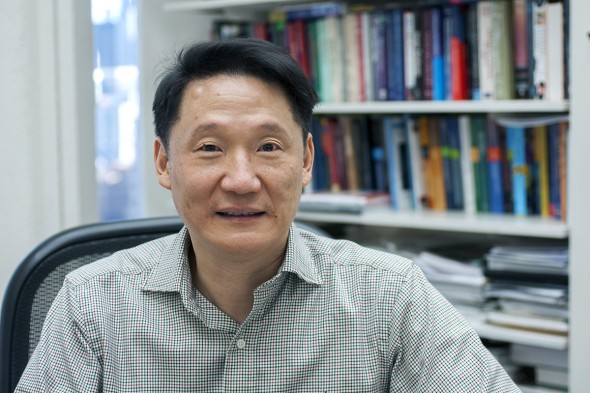Digging into the patterns of Big Data

“There is so much that we can use in a constructive way,” says information technology expert Philip Yu. Photo: Joshua Clark/UIC Photo Services
The University Scholar award, now in its 30th year, honors UIC faculty who are among the best in their fields — those who show superior performance and great promise in research and teaching. Winners receive $15,000 per year for three years.
We are living at the beginning of the era of Big Data, when buying something at the local big-box store can produce a personal profile the NSA would envy.
“A lot of your daily activity is being captured,” says Philip Yu, distinguished professor and Wexler chair in information technology.
While this may seem worrying, Yu sees things differently. He is one of the foremost experts on data mining — identifying patterns, then using them to extract information from huge data sets.
Yu came to UIC in 2008 after 29 years at IBM, where he had become an internationally renowned researcher. His impact on the field is fundamental and shows no sign of slowing, says Robert Sloan, professor and head of computer science.
Since 2011, Yu has published 102 conference papers, 36 journal articles, co-edited a book and given 32 keynote and invited talks. “These are normal 23-year numbers, not three-year numbers, for a successful full-time professor,” Sloan says, adding that Yu’s lifetime publication total, 776 papers with a citation count of 49,390, is unprecedented.
Yu has enormous enthusiasm for the possibilities in his field. “There is so much that we can use in a constructive way,” he says.
Yu envisions a time when we will be able to diagnose illness; understand pollution; know where and when a tornado is coming; and get dead-on recommendations from Amazon.
One of his current collaborations is with neuroscientists looking at brain images, fMRIs of the brain, to detect early anomalies in the brain related to disease. Currently, the changes to the brain wrought by diseases like Alzheimer’s and Parkinson’s can’t be seen until it’s far too late. Yu is working on advanced techniques to detect these diseases more accurately and earlier, bringing the possibility of early intervention and, possibly, prevention.
Instead of analyzing the image, Yu maps the image into a network and looks at connectivity, comparing healthy brains and brains suspected of disease.
“The brain is a big thing with million of connections,” he says. “We are in this exciting era of big data with a tremendous opportunity to use this data to enrich our lives.”
